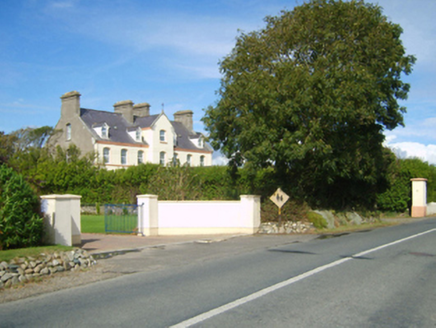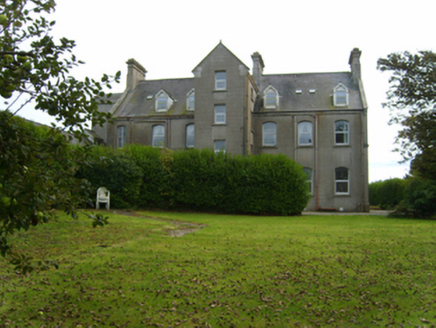Survey Data
Reg No
15620006
Rating
Regional
Categories of Special Interest
Architectural, Artistic, Historical, Social
Original Use
Convent/nunnery
Historical Use
Nursing/convalescence home
Date
1900 - 1910
Coordinates
299068, 106663
Date Recorded
21/09/2007
Date Updated
--/--/--
Description
Detached seven-bay two-storey convent with dormer attic, designed 1905; built 1905-8; opened 1908, on a cruciform plan centred on single-bay full-height gabled projecting breakfront; single-bay (single-bay deep) full-height central return (north). Occupied, 1911. Closed, 1987. Renovated, 1999, to accommodate alternative use. For sale, 2007. Pitched slate roof on a cruciform plan including gablets to window openings to dormer attic centred on pitched (gabled) slate roof (breakfront), roll moulded clay ridge tiles, cut-granite coping to gables on cut-granite "Cavetto" kneelers with rendered chimney stacks to apexes centred on paired rendered chimney stacks having "Cyma Recta"- or "Cyma Reversa"-detailed cornices below capping supporting terracotta or yellow terracotta pots, trefoil-detailed timber bargeboards to gablets, paired rooflights to front (south) pitch, and cast-iron rainwater goods on cut-granite cornice retaining cast-iron downpipes. Rendered, ruled and lined walls on cut-granite chamfered cushion course on rendered, ruled and lined plinth. Camber- or segmental-headed central door opening into convent. Camber- or segmental-headed window openings with cut-granite sills (ground floor) or cut-granite sill course (first floor), and concealed dressings having bull nose-detailed reveals framing replacement uPVC casement windows replacing two-over-two timber sash windows. Set in landscaped grounds with rendered piers to perimeter having pyramidal capping supporting wrought iron double gates.
Appraisal
A convent erected to designs signed (1905) by William Henry Byrne and Son (formed 1902) of Suffolk Street, Dublin (DIA), representing an important component of the early twentieth-century built heritage of south County Wexford with the architectural value of the composition confirmed by such attributes as the symmetrical footprint centred on a restrained doorcase, albeit one concealed by a later porch; the slight diminishing in scale of the openings on each floor producing a graduated visual impression; and the miniature gablets embellishing the roofline. Having been well maintained, the elementary form and massing survive intact together with substantial quantities of the original fabric, both to the exterior and to the interior: however, the introduction of replacement fittings to most of the openings has not had a beneficial impact on the character or integrity of a convent forming part of a self-contained group alongside the adjacent Catholic Church of the Blessed Virgin Mary, Saint Anne and Saint Joseph (see 15620004) with the resulting ecclesiastical ensemble making a pleasing visual statement in a rural village street scene.





